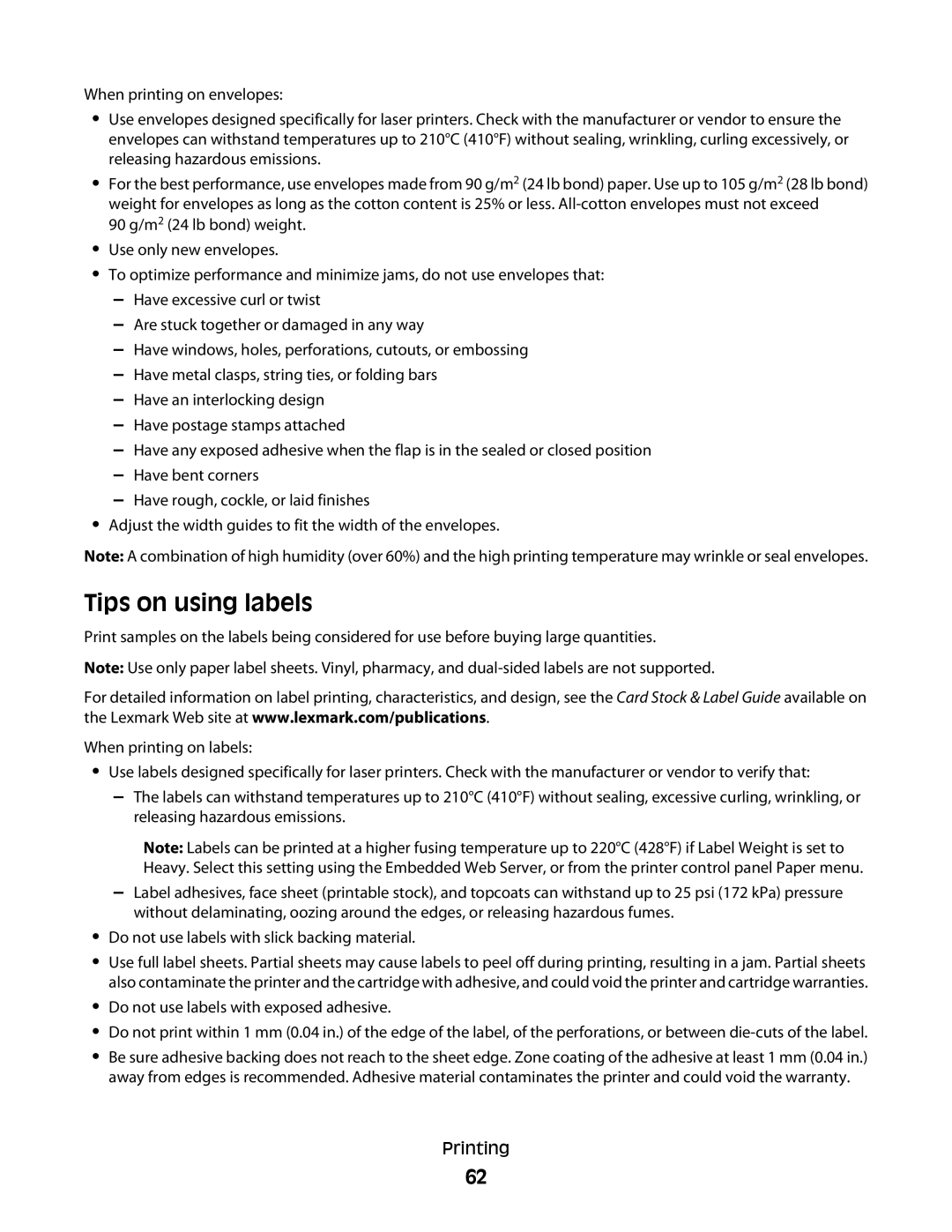Printing
62
Do not print within 1 mm (0.04 in.) of the edge of the label, of the perforations, or between die-cuts of the label.
Do not use labels with exposed adhesive.
•
•
• Be sure adhesive backing does not reach to the sheet edge. Zone coating of the adhesive at least 1 mm (0.04 in.) away from edges is recommended. Adhesive material contaminates the printer and could void the warranty.
– The labels can withstand temperatures up to 210°C (410°F) without sealing, excessive curling, wrinkling, or releasing hazardous emissions.
Note: Labels can be printed at a higher fusing temperature up to 220°C (428°F) if Label Weight is set to Heavy. Select this setting using the Embedded Web Server, or from the printer control panel Paper menu.
– Label adhesives, face sheet (printable stock), and topcoats can withstand up to 25 psi (172 kPa) pressure without delaminating, oozing around the edges, or releasing hazardous fumes.
• Do not use labels with slick backing material.
• Use full label sheets. Partial sheets may cause labels to peel off during printing, resulting in a jam. Partial sheets also contaminate the printer and the cartridge with adhesive, and could void the printer and cartridge warranties.
Use labels designed specifically for laser printers. Check with the manufacturer or vendor to verify that:
•
Note: A combination of high humidity (over 60%) and the high printing temperature may wrinkle or seal envelopes.
Tips on using labels
Print samples on the labels being considered for use before buying large quantities.
Note: Use only paper label sheets. Vinyl, pharmacy, and dual-sided labels are not supported.
For detailed information on label printing, characteristics, and design, see the Card Stock & Label Guide available on the Lexmark Web site at www.lexmark.com/publications.
When printing on labels:
When printing on envelopes:
•Use envelopes designed specifically for laser printers. Check with the manufacturer or vendor to ensure the envelopes can withstand temperatures up to 210°C (410°F) without sealing, wrinkling, curling excessively, or releasing hazardous emissions.
•For the best performance, use envelopes made from 90 g/m2 (24 lb bond) paper. Use up to 105 g/m2 (28 lb bond) weight for envelopes as long as the cotton content is 25% or less. All-cotton envelopes must not exceed
90 g/m2 (24 lb bond) weight.
•Use only new envelopes.
•To optimize performance and minimize jams, do not use envelopes that:
–Have excessive curl or twist
–Are stuck together or damaged in any way
–Have windows, holes, perforations, cutouts, or embossing
–Have metal clasps, string ties, or folding bars
–Have an interlocking design
–Have postage stamps attached
–Have any exposed adhesive when the flap is in the sealed or closed position
–Have bent corners
–Have rough, cockle, or laid finishes
•Adjust the width guides to fit the width of the envelopes.
